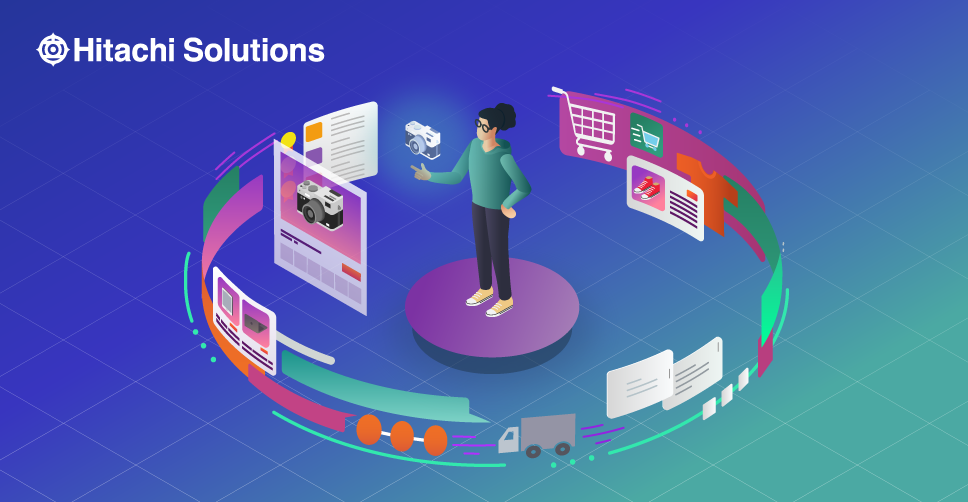

Compete and Win With an Intelligent Supply Chain
Create operational agility with analytics, automation, and new delivery models.
Download the WhitepaperIf you’re in the retail industry, you know that the competition is unlike anywhere else. Businesses are using every available sales and marketing avenue to convert shoppers into customers and customers into long-term, loyal consumers.
While retailers may be taking advantage of new sales channels like social media accounts and ecommerce platforms, so is everyone else. To keep up with — and hopefully surpass — the competition, businesses need to deliver personalized, unique experiences. That’s where omnichannel retailing comes in.
What is Omnichannel Retailing?
Today’s consumers are researching, browsing, and purchasing products on multiple channels and devices. In fact, 73% of retail consumers use multiple channels to shop, which is why many retail brands have adopted an omnichannel retail strategy.
Today’s consumers are researching, browsing, and purchasing products on multiple channels and devices. In fact, 73% of retail consumers use multiple channels to shop, which is why many retail brands have adopted an omnichannel retail strategy.

With an omnichannel approach, retailers develop one strategy that is executed across all channels to create a connected, customer-focused experience. This means that a shopper who begins browsing on a brand’s website will have the same experience whether they visit the brand’s mobile app, social media accounts, or brick-and-mortar store and whether they use a mobile phone, tablet, desktop computer, or laptop. An omnichannel retail strategy also enables customers to convert through any of these available online or offline touchpoints.
In addition to consistent customer experiences and unified branding, there are many business opportunities that come with omnichannel retailing. Companies that implement omnichannel tactics see a 90% higher customer retention rate than those who do not.

Omnichannel Retail Trends
Every retailer needs to strategize specific ways to align their brand, company goals, and customer needs. Below are a few trends that retailers are tailoring to their business.
Augmented Reality
Customers might be hesitant to order certain products online. A couch, for example, might be available at a great deal but not knowing how it will look in a certain environment might deter someone from adding it to their cart.
A modern-day spin on “try before you buy,” augmented reality (AR) is an easy and interactive way for customers to visualize products in a real-world, at-scale setting. Shoppers simply select a product to be superimposed into their environment and can then decide if they’d like it in a different size, shape, color, or other option. For example, popular Swedish furniture retailer IKEA enables consumers to virtually “place” true-to-scale 3D models of sofas, coffee tables, bookcases, and more in their home using the IKEA Place app. Recent updates to the app have even made it possible for shoppers to visually search for products by simply pointing their camera at an object and automatically pulling similar items. AR brings inventory directly to the customer and can help boost customer confidence, reduce shopping cart abandonment, and limit returns.https://www.youtube.com/embed/UudV1VdFtuQ
And furniture stores aren’t the only retailers getting in on the AR trend. In 2017, popular makeup retailer Sephora unveiled its “New Sephora Experience,” featuring AR-powered Virtual Artist service. Using Virtual Artist, customers can try out different products, choosing from thousands of looks, and get personalized recommendations using an iPad or connected mirror. Once they’re happy with the end result, customers can share their virtual makeover on Beauty Board, Sephora’s branded social media platform. Virtual Artist has been so popular that Sephora has even extended the capability to its mobile app.
Both Virtual Artist and Beauty Board are part of Sephora’s Beauty Hub; with digital capabilities, shoppable connected terminals, and tables for in-store live tutorials, Beauty Hub is the ultimate in omnichannel retail experience.
In-Store Mobile Connectivity
Companies like Starbucks have fully embraced mobile app capabilities by enabling their customers to place orders on their phone for in-store pickup. The coffee giant has even created a loyalty program that rewards customers every time they use their mobile app to pay. It’s no wonder, then, that 48% of smartphone owners said that the Starbucks app is their favorite restaurant loyalty rewards app.

But that’s not all: The Starbucks app also offers other in-store mobile features, such as a Spotify integration to identify songs and artists playing in-store and personalized food and beverage recommendations based on a customer’s order history. Not only does this give consumers an incentive to visit Starbucks over other coffee shops, it’s also an opportunity for the company to use its app as a way to market and upsell to existing customers.
Another great example of a major retailer using mobile connectivity to enhance the in-store experience is Target. The big box retailer recently rolled out the latest iteration of its free nationwide loyalty rewards program, Target Circle. There are a few different ways for consumers to sign up for Target Circle, including providing their phone number at checkout, but the easiest way is through the Target app. Customers can use the Target app to see whether items are in stock at their local store before they make a trip, saving them valuable time and effort. They can also use their mobile device to scan barcodes in store and gain access to exclusive Target Circle offers, including product discounts and rewards. If the success of Target Circle’s predecessor is any indication — shoppers cashed in over $1.6 billion in discounts using Target Cartwheel — the company is sure to have another hit on its hands.

Starbucks and Target are just two retailers using in-store mobile connectivity to their advantage. Given the fact that 60% of shoppers look up product information while using their mobile devices in-store, unifying the two channels is an effective way to recruit and retain customers.

Personalization
Tech-savvy shoppers know when they’re being marketed to. And with shoppers visiting various channels across multiple devices, generic strategies will only lead to generic customer experiences.
Delivering tailored content and product recommendations is how modern-day retailers captivate shoppers. In fact, 80% of consumers are more likely to make a purchase when brands offer personalized experiences.

Here are just a few examples of the ways different brands have incorporated personalization into their omnichannel retail strategy:
- Nordstrom “remembers” returning customers’ clothing size based on their previous online shopping behavior.
- Stitch Fix creates a curated monthly subscription box with hand-selected items based on the customer’s style preferences.
- ASOS uses social media data to offer new and existing customers personalized discounts and deals on products they’re interested in.
- Nike’s “Nike By You” campaign allows online shoppers to express themselves by creating customized product designs.
Personalization should extend to every aspect of a brand’s omnichannel retail strategy, from the types of product recommendations customers receive to the types of advertisements they’re targeted with. By far, the best way to achieve this granular level of personalization is by using a customer relationship management (CRM) system. CRM systems enable retailers to collect and analyze consumer data and use it to build out detailed customer profiles based on demographics, geographic location, purchase history, major life milestones, personal preferences, and more.
Industry experts have indicated that personalization will become even more relevant in the wake of COVID-19. With shoppers homebound, purchasing patterns and even the very nature of customer loyalty have changed significantly. For example, with more consumers opting to stay at home and cook for themselves rather than eat out, retailers can likely expect an increase in cookware sales. And with small businesses shuttering as a result of economic instability, there’s been an increased emphasis from consumers on buying local. These are all important data points and key indicators of how external factors influence consumers’ decisions. To that end, in order to adapt to this new normal, retailers must leverage both internal and external data to gain a holistic view of the customer and interact with them on their own terms.
Store Communication Platforms
As safe-at-home orders start to lift and brands resume in-store operations, retailers really need to stick the landing on the “grand reopening” in order to recapture consumer interest. For that to happen, top retail brass and brick-and-mortar employees need to be in sync on all things.
For businesses in need of inspiration, look no further than Lush Cosmetics. In 2019, the popular organic beauty retailer partnered with Retail Zipline to develop a store communication and workflow platform to foster better communication between company executives and store associates and managers. Employees simply download an app to their mobile device and log in at the beginning of their shift. Throughout the day, employees can check the app for important updates and messaging about everything from product launches to merchandising displays to in-store marketing campaigns — essentially, everything they need to help ensure a consistent customer experience across all of the company’s sales channels.
And as we know, it’s all about delivering a consistent customer experience — so much so, in fact, that 69% of U.S. consumers report shopping more with brands that offer a consistent experience across their in-store and online channels.

Contactless Shopping & Autonomous Payment
Contactless shopping and autonomous payment have existed in some form or other since the 1990s but have seen an uptick in popularity in recent years with the rise of shoppers using smartphones and other mobile devices to process payments. Now, in light of COVID-19, the demand for contactless shopping has reached new highs, with 87% of shoppers reporting that they would prefer to shop in stores with touchless or robust self-checkout options.

Walmart was one of the brands to lead the contactless shopping charge, introducing QR code scanning to the Walmart Pay app, online ordering with contactless pickup, and signature-free delivery. Other retailers have followed suit: From Dick’s Sporting Goods to Publix to Kohl’s, businesses across the country are offering limited-contact services.
It’s clear that contactless shopping and autonomous payment are no longer just a matter of convenience — for many shoppers, they’re a matter of safety. From an omnichannel retailing perspective, the smartest thing brands can do is leverage their digital and physical resources to accommodate this demand.
Social Integration
There’s no doubt about it: Consumers are visually oriented. To that end, social media has become an effective way to engage with consumers because it enables brands to permeate their feeds with aesthetic images that appeal to their visual senses.
Instagram has long been a popular advertising platform for retailers but the social networking service really shook things up when it introduced the Instagram Shopping functionality. An “immersive storefront,” Instagram Shopping enables consumers to shop for all of their favorite brands while scrolling without ever having to exit the app. Instagram Shopping even offers a streamlined mobile checkout system, incentivizing customers to make more impulsive purchases. Instagram recently extended this functionality to an even broader audience of creators, turning the platform into its own veritable all-in-one marketing and sales hub.
As a trend, social integration is an excellent example of the evolution of omnichannel retailing — in order to capture and keep the attention of younger generations, many of whom are digital natives, retailers need to reach them through their favorite platforms.
Artificial Intelligence & Machine Learning
Artificial intelligence (AI) and machine learning consistently top omnichannel retailing trends lists, and for good reason: There are numerous applications for AI and machine learning in omnichannel retailing, from building propensity models to optimizing order fulfillment to refining customer segmentation.
Some brands have even found creative ways to leverage AI and machine learning to enhance the customer experience. For example, Domino’s Australia developed the DOM Pizza Checker, a state-of-the-art system that uses advanced machine learning, AI, and sensor technology to analyze and verify topping distribution to ensure pizza quality and consistency. Although it might sound like more of a novelty than anything else, the DOM Pizza Checker was an overnight success: By July 2019 — just one month after its debut — it had boosted product quality scores by 15%.

Another clever example of an AI-driven omnichannel retail strategy is the popular skincare company Olay’s Skin Advisor. Shoppers simply snap a selfie and answer a few basic questions about their skincare preferences and concerns, then Olay’s AI technology evaluates their “skin age” based on a number of factors, including fine lines and dark spots, and uses it to generate a custom skincare regimen. Once the consumer has their regimen, they can shop products through the Olay website and have them delivered straight to their door. According to Olay, the company scanned over 50,000 faces when developing Skin Advisor tool, meaning everything is supported by data and has had over 1 million users since unveiling the technology.

An Omnichannel Retail Strategy in Action
We realize we’ve covered a lot of ground so far, so let’s stop for a moment and imagine what some of these omnichannel retail trends might look like in action in the form of a (fictional) omnichannel retail customer journey:
Cameron Needs a Couch
While out shopping one day, Cameron visits a furniture store called Fantastic Furnishings to look at couches. He sees a few that he likes but wonders whether the brand has more styles in stock. He approaches a store associate, who informs him that there are additional styles on the company’s website. He also mentions to the associate that he recently moved and is in the process of furnishing his new place; the associate asks him a few questions about his design preferences and makes a note of this information in Fantastic Furnishing’s CRM system.
Later that day, Cameron goes online to look at additional couch options. He finds one that he thinks will be perfect in his living room and uses the website’s augmented reality feature to see how it would look in the space. Cameron customizes his order, choosing from a variety of fabric options and adding a left-side chaise sectional and built-in storage, before completing his purchase. He chooses to have it delivered to his home rather than pick it up in store.
Once Cameron’s order comes through, Fantastic Furnishing’s enterprise resource planning system automatically scans available inventory to see whether there are any items currently in stock that match his order to ensure the shortest possible fulfillment window. Seeing that it’s a custom order, a work order is submitted, and Cameron’s custom couch is assembled. Once it is complete, warehouse staff use an AI-powered system to scan the couch for imperfections, and it is loaded onto a truck for delivery. Using Fantastic Furnishing’s mobile app, Cameron is able to track his shipment in real-time, using GPS technology to see the truck’s exact location.
A few days later, Cameron receives a follow-up email from the company to see whether he was happy with his experience. Over the following months, Cameron receives targeted ads for Fantastic Furnishings through Facebook, Instagram, and Twitter recommending additional products curated to his particular tastes based on the preferences recorded within the company’s CRM system.
How to Implement an Omnichannel Retail Strategy
Every omnichannel retail strategy needs to start somewhere — namely, by gaining a holistic view of all available sales channels, including:
- Brick-and-mortar stores
- Ecommerce platforms
- Social media accounts
- Email marketing campaigns
- Telephone sales
- Mobile apps
- And so on
When defining these various channels, try to see things from the customer’s perspective. Ask yourself, “What purpose do each of these channels serve? Which customer segments do they serve? What is it that my customers want from each of these channels?” Different members of your audience might want different things — for example, an older audience might simply want to make a transaction and only talk to someone when they need assistance, whereas a younger audience might be looking for a greater sense of community. These questions will be vital toward developing your omnichannel retail strategy.
From there, the next step is to figure out where your audience lives. Not literally — though that information is helpful toward developing a 360-degree view of the customer — but figuratively speaking in terms of which websites they visit, what devices they use, and through which channels they like to shop. This will not only help you figure out where to concentrate your marketing spend, it will also present you with opportunities to engage with your audience. Just be mindful to interact with consumers on their own terms — if you come across as too pushy, you could risk alienating them.
An easy way to take advantage of these various channels is to make sure all of your touchpoints are shoppable through social integration. If your audience congregates on Instagram, use the Instagram Shopping functionality; if they like to build mood boards on Pinterest, invest in a Pinterest business account; and so on. This will not only increase the number of impulse purchases your customers make but could also potentially expose you to new audiences.
Next on deck, focus on creating a consistent experience. As we mentioned earlier, consistency is incredibly important to consumers, so it’s important that your in-store customer experience blend seamlessly into your online customer experience, and vice versa. First and foremost, make sure your branding, messaging, and customer service are uniform both online and offline. Next, take advantage of omnichannel trends such as in-store mobile connectivity to blend the digital and physical worlds. One effective way to do this is to incentivize consumers to shop using mobile coupons — you can even use geofencing to send them discounts and promotions via push alerts in-store when they approach certain products. In fact, given the effect that COVID-19 has had on the retail industry, discounts and promotions are likely to become more important than ever before as brands deploy new marketing tactics to move inventory off shelves.
Last, but certainly not least, make sure analytics is at the heart of everything you do. Data can provide a wealth of insight not only into your customers’ behaviors and preferences, but also into the efficacy of different marketing campaigns and your omnichannel retail strategy on the whole. Collect as much data as you possibly can and invest in data science and analytics tools in order to transform it into meaningful insights.
So, to review:
- Gain a holistic view of your sales channels
- Try to see things from the customer’s perspective
- Figure out where your audience “lives”
- Engage with your audience
- Make sure all of your touchpoints are shoppable
- Focus on creating a consistent customer experience
- Incentivize customers to shop wherever you can, and
- Make sure analytics is at the heart of everything you do
By following these basic tenets of omnichannel retailing and incorporating some of the trends listed above, you are bound to create a winning omnichannel retail strategy.
Take the Next Step
With customer loyalty up for grabs, now is the time to strike by implementing a foolproof omnichannel retail strategy — and Hitachi Solutions is here to help. From retailers to restaurants, we’re uniquely positioned to help businesses implement the full suite of end-to-end capabilities that Microsoft Dynamics 365 has to offer.
That’s not all — we have multiple teams dedicated to different components of the omnichannel retailing experience, including:
- A member experience team that helps businesses like yours enhance the customer experience
- A data science team that helps retailers gain a real-time view of the latest trends using the power of analytics
- A modern data estate team that enables brands to make data accessible and usable through omnichannel integration
- And more
And that’s only a fraction of what Hitachi Solutions can do for you. Contact us today to find out how our omnichannel retail technology and expertise can transform your business.


